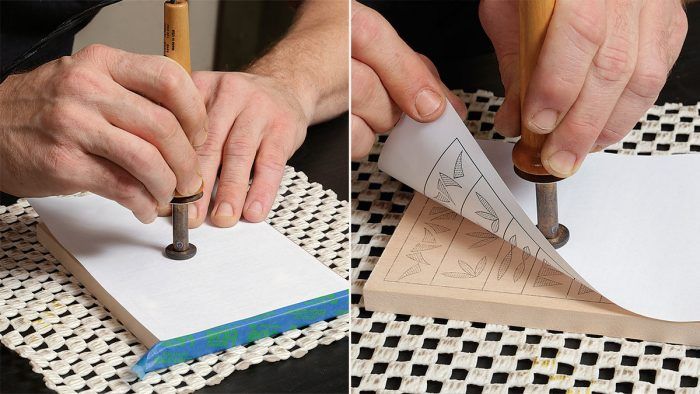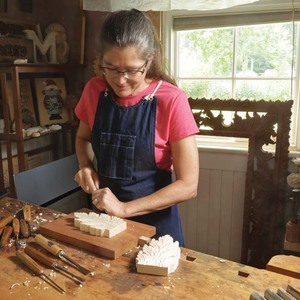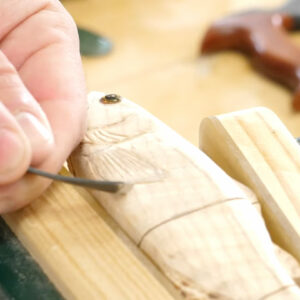Download: Daniel Clay’s Chip Carving Pattern
Building chip-carving skills is about repetition. Daniel Clay's pattern provides an excellent foundation, taking you from basic cuts to more advanced ones.
While a completed Swiss-style chip-carved pattern looks intricate and mesmerizing, when you break it down, it’s often just a series of repeating elements and motifs. Indeed, the bulk of designs comprise just two- and three-corner chips. These basic examples can appear in a wide variety of shapes and sizes, which can be assembled and combined into an infinite number of designs. Once you become familiar with these simplest forms, you’ll begin to recognize them in virtually every chip carving you encounter.
That’s where this sample board comes in. I’ve organized it to help you get in the necessary reps while still building your skill set from the ground up. It begins with small, tight, equilateral triangles—three-corner chips—and progresses to triangles with different geometries and spacing. The two-corner chips advance in the same way, starting with a basic lens shape before amping up the difficulty just the right amount. At the end is a series of tumbling three-corner chips with rounded sides.
As for the wood, start with basswood. Its fine, straight grain, virtually homogenous creamy color, and, above all, softness and workability make it ideal for chip carving. Other workable woods include butternut, Spanish cedar, eastern white pine, catalpa, and paulownia. Though it is possible to carve harder, denser woods such as walnut, I strongly recommend that you begin with basswood. It’s easy to carve, easy to find, and very affordable. I particularly prefer basswood that has tighter grain. Moisture content is also important. Wood that has been dried to about 10% to 12% moisture content is best, as it will carve easily and take detail well. Dry, brittle wood is much harder to carve. It will crunch and crush under the knife and is more likely to split.
Use heat to transfer a printed pattern to the board
To do this, place the pattern facedown on the wood and run a transfer tool, similar to a wood-burning pen and available from art-supply stores, all over it. The pattern must be printed with toner, such as that used in laser jet printers. Spot check as you remove the pattern. Starting at a corner, lift off the pattern slowly, reheating areas that didn’t transfer sufficiently.
This is an excerpt from Daniel’s article Start Chip Carving in Fine Woodworking issue #278























Comments
Good article. However, the pdf download gives one page with two identical images so that when I print it I get two very small images on one 8.5 by 11 page.
That's accurate to the pattern used in the article. We just put two on the page.
Hey Ben when I click on the PDF link I get nothing I am trying from my iPad should I be using my Computer?
The other suggestion might be if the image is small and you have access to a photocopier try enlarging it on the copier. Most copiers use toner to print.
Thanks Richg
That's odd. You're the second one to say that they can't download the PDF on their iPad. It's something we haven't been able to replicate here. Shoot me an email. [email protected]
Help please on the transfer method. I am relatively new to carving and I would like some more information for the following text in the article:
"a wood-burning pen and available from art-supply stores, all over. The pattern must be printed with toner, such as that used in laser jet printers."
1. I have searched Amazon and my local art supply store and can not find this 'wood burning pen' as shown in your picture with a flat bottom. What is it named or can you post a link to the manufacture please.
2. I understand the laser jet toner but what kind of paper? Just copy paper? Freezer paper, etc.
Otherwise the article was awesome, I did have trouble with the PDF download as mentioned above but eventually figured it out.
This is a practice session that I've been looking to find.
Thank you,
Daniel
Hi Daniel,
Thanks for the questions. Glad you like the article, too. Here's the link for the transfer tool. And yes, regular copy paper should work.
“[Deleted]”
My version on Apple laptop (10.13) does not recognise the installer so will not get further! I also only have an inkjet printer so the file will be useless to me.
Woodiemet
Log in or create an account to post a comment.
Sign up Log in